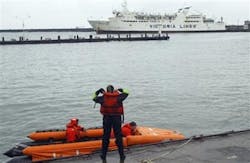Officials Eye Weather and Pilot Error in Deadly Russian Crash
SOCHI, Russia_Boats laden with bodies sailed into the palm-fringed harbor of this Russian resort Wednesday, carrying an Armenian airliner's orange tail section and the remains of some of the 113 people who died when the plane tumbled into the Black Sea.
The plane went down about 2:15 a.m. in heavy rain and poor visibility as it was approaching the airport in Adler, about 12 miles south of this city wedged between the sea and soaring snowcapped mountains. Most of the dead were Armenians.
"I've lost my sweetheart, my son!" Anait Bagusian, 50, wailed at Zvartnots Airport in the Armenian capital, Yerevan, from which Armavia Airlines Flight 967 originated. Doctors hovered nearby because she swooned several times.
Authorities were investigating the cause of the crash as divers attempted to retrieve the Airbus A-320's recorders from the deep, wave-chopped site about 3 1/2 miles offshore.
A spokeswoman for the Prosecutor General's office, Nataliya Vishnyakova, dismissed the possibility of terrorism. Other officials pointed to the rough weather or pilot error as the likely cause. It is difficult even under normal conditions to land at the airport, which can be approached only from the sea.
Salvage ships battled stiff winds and heavy seas to try to recover bodies and fragments of the plane, which was leased by Armavia, Armenia's largest airline. By evening, 47 bodies had been brought into the port and taken to morgues for identification.
Outside one morgue, about 100 people stood grimly, rushing forward every time a truck carrying remains pulled up to the gates. They waited for any word of identified bodies from coroners.
"Tell me anything. Anything! I know nothing now!" said a teary-eyed ethnic Armenian man who gave his name only as Zaghar, reflecting the wide distrust of authorities within Sochi's large Armenian community.
Zaghar said he had flown to Sochi from Moscow, where he works as a businessman, and had invited his mother and father in Armenia to join him for a fishing vacation.
"I sent for them! I sent them money to fly here so we could vacation together! And look what happened!" the 49-year-old said, shaking his hands at the sky, his eyes welling up with tears.
A 47-year-old man who gave his name only as Misha said his brother, sister-in-law and nephew had also been aboard the plane.
"The women are all home crying. The men are all standing here waiting. What else can we do?" he said.
Transport Minister Igor Levitin said the body of a child was the only passenger identified with certainty and that identifying the others would be difficult.
At Zvartnots Airport in Armenia, Samvel Oganesian said his 23-year-old son, Vram, and his friend Hamlet Abgarian had been heading to Sochi for vacation.
"Why did he go?" Oganesian asked in anguish, over and over again.
Russian President Vladimir Putin and Armenian President Robert Kocharian declared Friday a day of mourning in both countries.
The airline said 26 Russians, one Ukrainian and one Georgian were among the passengers, while the rest were Armenian citizens. But Interfax cited Armenian civil aviation spokesman Gayane Davtian as saying no Georgians or Ukrainians were aboard. The passengers included the airline's deputy general director, Vyacheslav Yaralov, the airline said.
The plane broke up on impact, and passengers' personal belongings and plane fragments were found scattered over an area spreading a mile from the crash site.
There were conflicting statements about the events leading to the crash.
Emergency ministry spokesman Viktor Beltsov said the plane disappeared from radar screens while trying to make a repeat attempt at an emergency landing. However, Interfax quoted the Russian air control agency as saying the plane's crew had not declared any emergency.
Armavia deputy commercial director Andrei Agadzhanov said in Yerevan that the crew had communicated with ground controllers while the plane was flying over the Georgian capital, Tbilisi. The ground controllers said the weather in Adler was poor but the plane could still land, Agadzhanov said. Just before the landing, however, the ground controllers told the crew to circle in the air again before approaching the airport and then it crashed.
Agadzhanov said the crew was highly experienced, the airplane was in good condition and that weather conditions were "certainly" the cause. The plane was manufactured in 1995 and underwent full-scale servicing a year ago, he said. A statement from Airbus said the plane had logged more than 28,200 flight hours.
Airlines in former Soviet countries wracked up a grisly record of crashes in the 1990s, following the whittling off of much of Soviet monopoly carrier Aeroflot into hundreds of regional airlines plagued by scant money, aging equipment and cavalier disregard for safety. They often flew badly overloaded. In an infamous 1994 case, 75 people were killed in a crash reportedly caused by the pilot's allowing his teenage son to take the controls.
In recent years, crashes from equipment failure or pilot error have declined sharply.
___
AP reporters Avet Demourian in Yerevan, Armenia, and Sergei Venyavsky in Rostov-on-Don, Russia, contributed to this story.
